In Brief
Humber foreshore - TA02C
A recording visit by Gabrielle Jarvis on 23 July has increased the total for this selected tetrad from 23 to a very respectable 170.
Stamford Bridge - SE75C
A combination of urban, woodland, disused railway line/nature trail and riparian sites produced a good list. Field edges and minor road verges mainly disappointing. Best finds Small toadflax and the aquatic plants.
[Tetrad total raised from 16 to 223 with over 60 new atlas spots!]
Gabrielle Jarvis & John Killingbeck, 20 July 2016
Folkton - TA07P
On a journey to Scarborough I took the opportunity to take a look at the villages of Flixton and Folkton. An hour-or-so poking about in the 30° heat raised the tetrad total to 119. Nothing special other than an infestation of Torilis nodosa in a well-mown lawn.
Richard Middleton, 19 July 2016
Slender Soft-brome
Slender Soft-brome Bromus lepidus was not uncommon before 2000. It was usually found among rye-grasses on grassy farm tracks. I have not recorded any since Atlas 2000 but found it on 15 July on the bare soil at the perimeter of a crop of wheat at TA308301 (TA33A). It is very much like an impoverished B. hordeaceus with glabrous spikelets occurring mainly in ones (to 3) on a pedicel. The sure diagnostic feature is the awn arising from the base of the wide sinus in the tip of the lemma. I'll carry a sample in the car for your delight at our next meeting.
Peter Cook, 19 July 2016
Hornsea Freeport
The coach and overspill car park at Hornsea Freeport (TA14Y) provided a grand total of 89 taxa on a wide range of synthetic habitats. A low bank of sand dividing parking spaces on which Filago minima and Aira caryophyllea were once known is now grassed over.
Peter Cook, 14 July 2016
The botanical value of ant mounds
I urge readers to always look at ant mounds in old grassland for they are well-drained micro-heaths. On a recent visit a cluster of ant mounds provided records of four species not seen anywhere else on the site.
In many years of botanizing I have found the following plants, often as the only one on the mound: Fern-grass, Sweet Vernal-grass, Tor-grass, Crested Hair-grass, Squirreltail Fescue, Restharrow, Thyme-leaved Sandwort, Early Forget-me-not, Sticky Mouse-ear, Parsley-piert, Hop-Trefoil and Stork's-bill.
Peter Cook, 28 June 2016
Gromwell Galore
On 24 June I passed a ca. 10-acre field in tetrad TA32G, East of Patrington, sown with Lithospermum arvense. Field Gromwell is being grown now as an alternative to fish as a source of omega-3 and omega-6 fatty acids. I think we should keep a record of sites where these 'new' crops have been sown to help future interpretation of sudden re-appearances.
Peter Cook, 25 June 2016
Upgraded selected tetrads
Records submitted by Rohan Lewis have pushed totals above 100 for two of the Wolds' selected tetrads - SE95J and SE96D.
19 May 2016
Botanical training
A series of three botanical training courses have been organised for this summer by the Hagge Wood Trust at Escrick. See their website for more details.
SE92E - Ellerker Ings
An unremarkable but unvisited selected tetrad; four hours hard work for 108 mundane taxa. The hectad total was boosted a little and now stands at about 393.
Richard Middleton, 9 May 2016
Watsonia 1960 to 2000 set (not checked). Free. Also, Eva Crackles' Flora. New, but no map overlays. £10. Collection/delivery by arrangement. Ring Peter 01964 614466.
TA22S - Ottringham North
It is MOT test time again and a list of 91 species accrued on a stroll up Station Road to the disused station area and back again. Contributions to the hectad TA22 total are expected to be few. Silver leafed Archangel Lamiastrum galeobdolon subsp. argentatum was observed spreading under a hedge well beyond a garden boundary.
Peter Cook, 5 May 2016
TA12S - Paull Holme
A recording visit to this selected tetrad by Bill and Janet Dolling has raised its total to 156 species.
30 April 2016
Danish Scurveygrass
Cochlearia danica is currently bountiful along our salted road verge strips. Make a note of where you see it on your travels. A patch here in Withernsea constitutes a first Hectad TA32 record!
Peter Cook, 28 April 2016
SE75W - Yapham
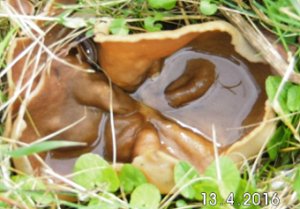
On our first meeting of the season we welcomed two participants from York University who made up the group to eight pairs of eyes scouring a tetrad with no post-2000 records. Prior study of the OS map indicated potential for arable, semi-improved grassland (pasture and road verge), hedgerow, wet woodland, chalk stream and urban ruderal habitats with easy access to all. A small patch of wet woodland in Meltonby yielded an extensive list of ground layer species many of which had already been found under hedgerows and grass verges elsewhere in the tetrad, notably Dog's Mercury, Sweet Violet, Primrose, Ramsons, Wild Arum and Bluebell. We also found Dewberry Rubus caesius growing along the bank of a shallow ditch and were delighted to find Goldilocks Buttercup growing very abundantly in road verge grassland together with Cowslip and Ground Ivy. The score for the day was a very respectable 148 of which 31 species were new hectad records raising the total to 312.
We also stopped to look at a bee fly, liverworts on the bank of the chalk stream, a river limpet and a cup fungus, possibly Helvella acetabulum (above), all contributing to an interesting day out.
We noted several arable fields that had recently been sprayed with herbicide. I am informed that some farmers that are severely affected by black grass are leaving affected fields fallow over Winter and early Spring to allow black grass to germinate and then 'burn off' all growth with a non-selective herbicide before sowing peas, beans or a grass ley.
Peter Cook, 15 April 2016
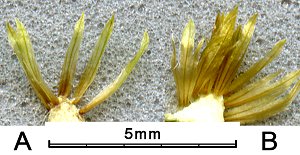 While exploring the parish allotments in Kelfield we were struck by two apparently different Galinsogas growing together. Not wishing to be too hasty with this variable Genus, I brought specimens of each home to ripen the seedhead for a definitive determination. The above image shows a head (minus seeds) of each type. Sample A has simple strap-like scales and sample B has broader tri-lobed scales. This confirms our field identification of Galinsoga quadriradiata for A (shorter, glandular-hairy plants) and G. parviflora for B (taller, almost glabrous plants).
While exploring the parish allotments in Kelfield we were struck by two apparently different Galinsogas growing together. Not wishing to be too hasty with this variable Genus, I brought specimens of each home to ripen the seedhead for a definitive determination. The above image shows a head (minus seeds) of each type. Sample A has simple strap-like scales and sample B has broader tri-lobed scales. This confirms our field identification of Galinsoga quadriradiata for A (shorter, glandular-hairy plants) and G. parviflora for B (taller, almost glabrous plants).
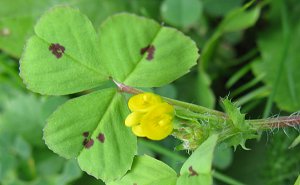 We enjoyed fine weather for our Local Group, end of season, trip to one of the furthest outposts of the vice-county. Despite the fact that many of the plants, particularly along the Ouse flood-bank, were by now unidentifiable, we did clock up an impressive 180 taxa. Among the star finds were Medicago arabica (above), Oenanthe crocata and Galinsoga quadriradiata. There had been much environmental "improvement" in the area and some of the more interesting plants found may have been introductions - Glebionis segetum, Centaurea cyanus, Rosa rubiginosa, &c."
We enjoyed fine weather for our Local Group, end of season, trip to one of the furthest outposts of the vice-county. Despite the fact that many of the plants, particularly along the Ouse flood-bank, were by now unidentifiable, we did clock up an impressive 180 taxa. Among the star finds were Medicago arabica (above), Oenanthe crocata and Galinsoga quadriradiata. There had been much environmental "improvement" in the area and some of the more interesting plants found may have been introductions - Glebionis segetum, Centaurea cyanus, Rosa rubiginosa, &c."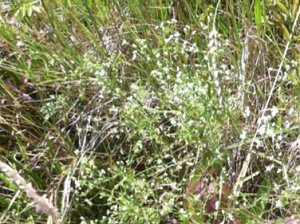 This tetrad currently has a wide variety of broad habitats including fore-, mid- and upper saltmarsh, relict sand dune, coastal dry grassland, arable field margins, fresh water ditches, brackish pools and swamp. There are Natura 2000, SSSI and two Local Wildlife Site designations on land soon to be consumed within the Welwick to Skeffling coastal defence realignment and habitat creation scheme. On recent 'covert special operations' in the area I have collected a further 44 species to add to the existing 164 post 2000 list, and have noted 'hot spots'. The most significant and satisfying find was a ca. 10 m x 1m ribbon of Stone Parsley (Sison amomum) plants approximately 100 m away from a site that was obliterated in the development of the Outstrays habitat creation scheme more than 10 years ago. It is not particularly photogenic but each white flower head is an umbel. A leaf is shown in the top left corner. See the RPR for status.
This tetrad currently has a wide variety of broad habitats including fore-, mid- and upper saltmarsh, relict sand dune, coastal dry grassland, arable field margins, fresh water ditches, brackish pools and swamp. There are Natura 2000, SSSI and two Local Wildlife Site designations on land soon to be consumed within the Welwick to Skeffling coastal defence realignment and habitat creation scheme. On recent 'covert special operations' in the area I have collected a further 44 species to add to the existing 164 post 2000 list, and have noted 'hot spots'. The most significant and satisfying find was a ca. 10 m x 1m ribbon of Stone Parsley (Sison amomum) plants approximately 100 m away from a site that was obliterated in the development of the Outstrays habitat creation scheme more than 10 years ago. It is not particularly photogenic but each white flower head is an umbel. A leaf is shown in the top left corner. See the RPR for status.
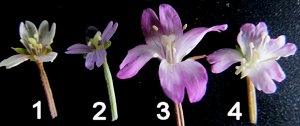 Scale indication - 'stem' width = 1 mm
Scale indication - 'stem' width = 1 mm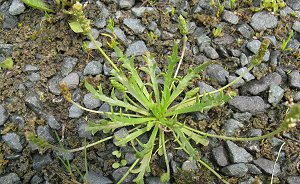 With only a single taxon recorded from this selected tetrad it hardly even deseved it's red spot on the map. A three hour recording visit this morning managed to add a further 137 taxa. This is not a lot but it seems to be about par for these very arable Wolds tetrads. A few nice chalk grassland species were hanging-on along one good, but overgrown, verge to the west of the village but most things were mundane. Nevertheless nine new plants were added to the hectad total, incuding a typical inland halophytic community of Buck's-horn Plantain Plantago coronopus, Lesser Sea-spurrey Spergularia marina and Reflexed Saltmarsh-grass Puccinellia distans. The photo above was taken in the parish chalk pit which has been used at some time, presumably, for storing road salt.
With only a single taxon recorded from this selected tetrad it hardly even deseved it's red spot on the map. A three hour recording visit this morning managed to add a further 137 taxa. This is not a lot but it seems to be about par for these very arable Wolds tetrads. A few nice chalk grassland species were hanging-on along one good, but overgrown, verge to the west of the village but most things were mundane. Nevertheless nine new plants were added to the hectad total, incuding a typical inland halophytic community of Buck's-horn Plantain Plantago coronopus, Lesser Sea-spurrey Spergularia marina and Reflexed Saltmarsh-grass Puccinellia distans. The photo above was taken in the parish chalk pit which has been used at some time, presumably, for storing road salt.
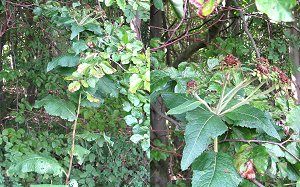 Not our finest hour; circumstances conspired to prevent our survey of the intended tetrad and a considered re-grouping was made in Kirby Grindalythe - another selected tetrad in SE96. This new tetrad had a previous, modest, total of 107 taxa and our efforts increased this by a further 50 with 16 new hectad records. Among the more interesting finds were Green Field-speedwell (Veronica agrestis) and flowering plants of Bulbous Buttercup (Ranunculus bulbosus) in a small dissused quarry and a huge specimen of Elecampane (Inula helenium) - pictured - in a roadside hedge.
Not our finest hour; circumstances conspired to prevent our survey of the intended tetrad and a considered re-grouping was made in Kirby Grindalythe - another selected tetrad in SE96. This new tetrad had a previous, modest, total of 107 taxa and our efforts increased this by a further 50 with 16 new hectad records. Among the more interesting finds were Green Field-speedwell (Veronica agrestis) and flowering plants of Bulbous Buttercup (Ranunculus bulbosus) in a small dissused quarry and a huge specimen of Elecampane (Inula helenium) - pictured - in a roadside hedge.
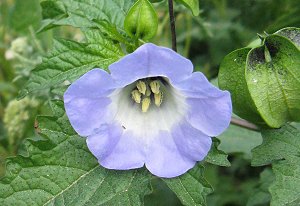 After a couple of lack-lustre hours examining TA1330 - Preston Road, Hull, I was temped onto a derelict site on the corner of Marfleet Lane. A large area of housing had been demolished and the ground levelled with a light, gritty material. The dominant plants seemed to be Chenopodiums both album and rubrum but sprinkled in with this was a strange mixture of aliens including the rather striking Nicandra physalodes (Apple-of-Peru, above). Other interesting plants were the bird-seed grasses Setaria viridis, Echinochloa crus-galli and Phalaris canariensis. Plenty of stray tomatoes (hinting at the origins of this association?) but also Ranunculus sceleratus, Rumex conglomeratus and Rorippa palustris!
After a couple of lack-lustre hours examining TA1330 - Preston Road, Hull, I was temped onto a derelict site on the corner of Marfleet Lane. A large area of housing had been demolished and the ground levelled with a light, gritty material. The dominant plants seemed to be Chenopodiums both album and rubrum but sprinkled in with this was a strange mixture of aliens including the rather striking Nicandra physalodes (Apple-of-Peru, above). Other interesting plants were the bird-seed grasses Setaria viridis, Echinochloa crus-galli and Phalaris canariensis. Plenty of stray tomatoes (hinting at the origins of this association?) but also Ranunculus sceleratus, Rumex conglomeratus and Rorippa palustris!
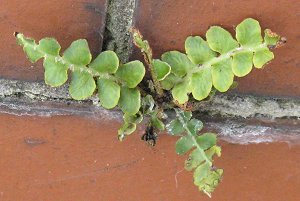 It's always good to meet up with old friends. The above picture was taken this morning while surveying TA0731. It shows a plants of Rustyback (Asplenium ceterach) growing on a garden wall near the cremetorium. I first discovered the fern on the same wall 16 years ago and it remained the only vc61 site for several years until the wall was "cleaned". Over the last decade I have made repeated visits to no avail but today there were four young plants so it's now officially back on the vc list!
It's always good to meet up with old friends. The above picture was taken this morning while surveying TA0731. It shows a plants of Rustyback (Asplenium ceterach) growing on a garden wall near the cremetorium. I first discovered the fern on the same wall 16 years ago and it remained the only vc61 site for several years until the wall was "cleaned". Over the last decade I have made repeated visits to no avail but today there were four young plants so it's now officially back on the vc list!
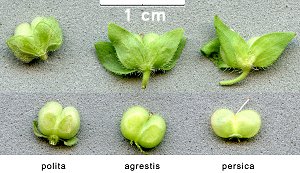 Over the last decade I have made very few records of either Veronica agrestis or V. polita and have often worried that I am grouping all weedy Speedwells as V. persica. I was very pleased yesterday to find a plant of V. polita on Auckland Avenue, Hull. Determined to make a careful comparison I brought a sample home and searched my garden in vain for V. persica to compare it against. On the plus side I found did find V. agrestis! (The parish allotments provided my persica). Above is a photograph of a seed capsule from each.
Over the last decade I have made very few records of either Veronica agrestis or V. polita and have often worried that I am grouping all weedy Speedwells as V. persica. I was very pleased yesterday to find a plant of V. polita on Auckland Avenue, Hull. Determined to make a careful comparison I brought a sample home and searched my garden in vain for V. persica to compare it against. On the plus side I found did find V. agrestis! (The parish allotments provided my persica). Above is a photograph of a seed capsule from each.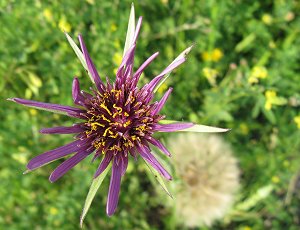 Yesterday, while out surveying an urban monad (TA0829) for the Hull Nats' atlas programme, I came across a single plant of Salsify (Tragopogon porrifolius) in a car park just off Spring Bank. The taxon has been known from this area for almost two decades but, so far as I am aware, it remains its only vc61 station.
Yesterday, while out surveying an urban monad (TA0829) for the Hull Nats' atlas programme, I came across a single plant of Salsify (Tragopogon porrifolius) in a car park just off Spring Bank. The taxon has been known from this area for almost two decades but, so far as I am aware, it remains its only vc61 station.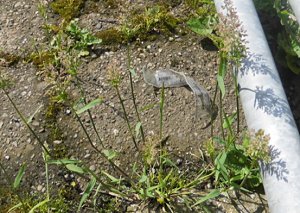
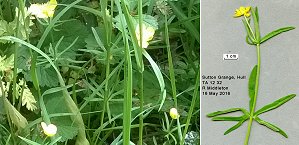 I was extremely pleased yesterday afternoon to discover a colony of Goldilocks Buttercup Ranunculus auricomus growing in a patch of relict woodland adjoining Saltshouse Road, Hull. There is a spot shown for TA13G in Crackles' 1990 Flora but I have been unable to determine whether it relates to this locality. How long the plants have been there and whether it was deliberately introduced I do not know but I can remember gathering Bluebells at the same spot sixty years ago!
I was extremely pleased yesterday afternoon to discover a colony of Goldilocks Buttercup Ranunculus auricomus growing in a patch of relict woodland adjoining Saltshouse Road, Hull. There is a spot shown for TA13G in Crackles' 1990 Flora but I have been unable to determine whether it relates to this locality. How long the plants have been there and whether it was deliberately introduced I do not know but I can remember gathering Bluebells at the same spot sixty years ago!
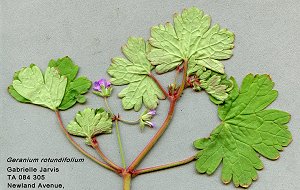
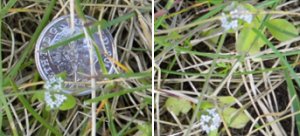 A recording visit to Welwick Bushes, primarily to look for lichens, was rewarded with some interesting new additions to the post 2000 list for this tetrad. Most remarkable was the second vc61 site for Valerianella locusta subsp. dunensis (D. E. Allen) Sell. This was first recorded by me at Chalk Bank, Spurn, (confirmed D E Allen) in March 1995. As the photo shows, against a 5p piece, it is a diminutive plant with only a few leaves and a head of flowers above the sand. Close-by was Sea Pearlwort Sagina maritima and a second site for Galium verum subsp. maritimum, first recorded last year (See Notes for 2015). In total, 9 taxa were recorded raising the tetrad total to 162. A thorough search for Lesser Chickweed Stellaria pallida, which is known to occur at this site, was unsuccessful at this visit.
A recording visit to Welwick Bushes, primarily to look for lichens, was rewarded with some interesting new additions to the post 2000 list for this tetrad. Most remarkable was the second vc61 site for Valerianella locusta subsp. dunensis (D. E. Allen) Sell. This was first recorded by me at Chalk Bank, Spurn, (confirmed D E Allen) in March 1995. As the photo shows, against a 5p piece, it is a diminutive plant with only a few leaves and a head of flowers above the sand. Close-by was Sea Pearlwort Sagina maritima and a second site for Galium verum subsp. maritimum, first recorded last year (See Notes for 2015). In total, 9 taxa were recorded raising the tetrad total to 162. A thorough search for Lesser Chickweed Stellaria pallida, which is known to occur at this site, was unsuccessful at this visit.
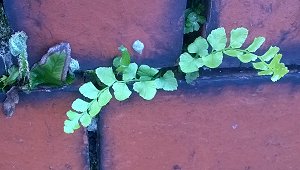 I recently found the pictured fern on a Hull garden wall. So far it has defied all attempts to give it a name. Could it be one of the rare Asplenium hybrids? More news will be posted as it becomes available.
I recently found the pictured fern on a Hull garden wall. So far it has defied all attempts to give it a name. Could it be one of the rare Asplenium hybrids? More news will be posted as it becomes available.

